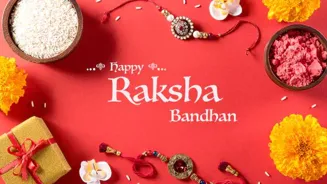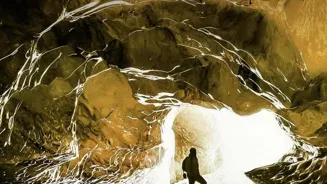Explore the Timeless Charm of Indian Folk Art: Discover 6 Unique Styles. Delve into vibrant tales and cultural heritage!
India, a land of vibrant cultures and rich traditions, boasts a diverse tapestry
of folk art forms. These art styles, passed down through generations, offer a glimpse into the soul of India, reflecting its history, mythology, and everyday life.
Unlike classical art forms with strict rules, folk art is often characterized by its simplicity, vibrancy, and connection to the local community. It uses natural materials like clay, wood, and vegetable dyes, making it deeply rooted in the environment.
Let's explore six captivating Indian folk art styles that continue to enchant art enthusiasts and inspire creativity even today.
Madhubani paintings: vibrant art from Bihar, depicting myths, nature, and culture, now global
Originating from the Mithila region of Bihar, Madhubani paintings are characterized by their bright colours and bold outlines.
Traditionally practiced by women on freshly plastered mud walls and floors of homes, these paintings depict mythological figures, scenes from epics like the Ramayana and Mahabharata, and natural elements like plants, animals, and birds.
Madhubani art is created using natural dyes extracted from plants and minerals, and the tools used are simple – twigs, brushes, and even fingers. The paintings often feature intricate geometric patterns and symbolic representations, conveying stories and celebrating festivals.
These paintings serve not only as a form of decoration but also as a means of preserving cultural knowledge and passing it on to future generations. The art also represents family stories.
Today, Madhubani paintings are thriving on paper and canvas, adorning homes and galleries worldwide, showcasing the enduring appeal of this ancient art form. The artists create unique designs without referring to any fixed books.
Warli paintings depict tribe's life & beliefs through simple geometric art on mud walls
Hailing from the Warli tribe of Maharashtra, Warli paintings are strikingly simple yet deeply evocative. Created using white pigment made from rice flour and water on a background of reddish-brown mud walls, these paintings depict scenes from daily life, rituals, and beliefs of the Warli tribe.
The figures are primarily geometric shapes like circles, triangles, and squares, representing humans, animals, and natural elements. The central motif is often a square representing the "chauk" or sacred enclosure, usually depicting a mother goddess.
These paintings offer a fascinating insight into the Warli tribe's worldview, their connection to nature, and their vibrant community life. Warli art is a testament to the power of simplicity and the beauty of storytelling through visual expression.
Unlike other tribal art forms, Warli painting doesn't employ religious symbolism and depicts life in general. These paintings adorn the local fairs and even displayed during certain ceremonies.
Traditional Pattachitra art depicts tales on cloth scrolls with natural pigments
Pattachitra, meaning "cloth picture," is a traditional art form originating from Odisha and West Bengal. These intricate paintings are created on cloth scrolls using natural pigments and depict mythological tales, religious narratives, and folk stories.
The artists, known as 'chitrakars', meticulously paint each scene with vibrant colours, bold lines, and elaborate details. Pattachitra paintings often narrate stories from the Ramayana, Mahabharata, and the Jagannath cult.
The colours used are derived from natural sources like minerals, stones, and plants, giving the paintings a unique earthy quality. Pattachitra is not just about creating beautiful images; it is about storytelling and preserving cultural heritage.
The 'chitrakars' often travel from village to village, narrating the stories depicted in their paintings, bringing art and culture to the people. These paintings are made on a piece of cloth which is coated with clay and gum made from tamarind seeds.
Ancient Indian art of Kalamkari: hand-painted textiles, natural dyes, mythological themes
Kalamkari, meaning "pen work," is an ancient Indian textile art form involving hand-painting or block-printing on cotton or silk fabric using a kalam (pen) and natural dyes.
There are two main styles of Kalamkari: Srikalahasti style, where the entire painting is done with a pen, and Machilipatnam style, where blocks are used for printing and details are added with a pen. Kalamkari paintings often depict mythological scenes, floral motifs, and intricate designs.
The dyes used are extracted from plants, roots, and minerals, giving the fabric a unique colour palette. Kalamkari is a labour-intensive process that requires skilled artisans and a deep understanding of the dyeing and printing techniques.
The art form is not only aesthetically pleasing but also eco-friendly, using sustainable materials and natural processes. Kalamkari textiles are prized for their beauty, craftsmanship, and cultural significance, adorning homes, clothing, and accessories worldwide.
This art is also linked with the story of the origin of the world.
Tanjore paintings: rich, vibrant art portraying Hindu deities with gold foil details
Originating from Thanjavur in Tamil Nadu, Tanjore paintings are characterized by their rich colours, intricate details, and the use of gold foil and precious stones. These classical South Indian paintings typically depict Hindu deities, mythological figures, and scenes from religious texts.
The paintings are created on wooden panels, with the figures adorned with gold foil, gemstones, and vibrant colours. The use of gesso work, a paste made of chalk powder and adhesive, adds a three-dimensional effect to the paintings.
Tanjore paintings are known for their opulence, grandeur, and the divine aura they exude. They are considered sacred objects and are often displayed in temples and homes as objects of worship.
Tanjore paintings are a testament to the artistic skill and religious devotion of the artisans who create them, preserving a rich cultural heritage. These artists were originally from the Raju community in Tanjore.
Gond art celebrates nature and tribal life through vibrant, detailed paintings
Gond art, originating from the Gond tribe of Madhya Pradesh, is a vibrant and colourful art form celebrating nature, mythology, and tribal life. These paintings are created using dots, dashes, and lines to depict animals, birds, trees, and deities.
The colours used are derived from natural sources like charcoal, coloured soil, plant sap, and leaves. Gond art is characterized by its intricate details, vibrant colours, and the use of geometric patterns.
The paintings often depict stories from Gond mythology, celebrating the connection between humans and nature. Gond artists believe that everything in nature is sacred and possesses a spirit, and their paintings reflect this deep connection to the environment.
Gond art is not just about creating beautiful images; it is about preserving cultural identity and celebrating the beauty of the natural world. The most popular topic is nature, forest and stories of God.
Indian folk art styles showcase rich heritage and creativity, supporting artisans
These six folk art styles represent just a glimpse into the vast and diverse world of Indian folk art. Each style has its unique characteristics, reflecting the culture, traditions, and beliefs of the region it originates from.
Exploring these art forms offers a deeper understanding of India's rich heritage and the creative spirit of its people. These art styles continue to thrive, evolving and adapting to modern times, while still preserving their traditional essence.
Supporting these art forms helps to sustain the livelihoods of the artisans who create them and ensures that these cultural treasures continue to be passed down to future generations.
Take the time to discover the beauty and magic of Indian folk art – you'll be amazed by the stories they tell and the cultural richness they represent. Support for these forms of art helps artisan's creativity.
AI Generated Content. Glance/InMobi shall have no liability for the content











